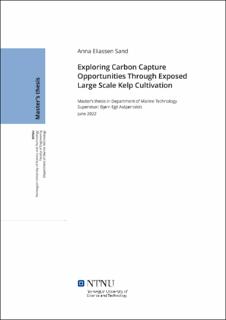| dc.description.abstract | Storskala taredyrking er en idé som får stadig økende oppmerksomhet her i Norge grunnet potensialet biomassen har som en mer bærekraftig erstatning til en rekke formål som for eksempel mat, fôr, og drivstoff. Høye produksjonskostnader i forhold til verdien av biomassen har så langt vært en barriere for oppskalering av dagens produksjon. Imidlertid forventes det at økende krav til bærekraftig produksjon, samt kutt i kostnader ved bruk av ny teknologi, skal kunne gjøre dette mulig i fremtiden.
En annen mulighet ved storskala taredyrking er utnyttelse av tarens evne til å fange karbon fra atmosfæren gjennom fotosyntese. Karbonet kan da langtidslagres enten ved at erodert biomasse synker til dypet eller begraves i sokkelen, eller gjennom metoder for å aktivt lagre karbonholdig masse.
Gjennom denne oppgaven presenteres et mulig design for et storskala taredyrkningsanlegg, samt operasjoner som kreves for å dyrke taren. Videre vil det gjennomføres en livssyklusanalyse for å estimere GWP for taren. I tillegg gjennomføres en studie av tarens potensiale til å fange karbon gjennom erosjon i vekstfasen samt av potensialer for utnyttelse av energien som er lagret i den høstede biomassen.
Analysen viser at råmaterialene brukt for å produsere tau har stor innvirkning, og videre vises det også at betydningen av tauenes livstid er av stor betydning. Andre faktorer som studeres er størrelse på anlegget og operasjonseffektiviteten, som begge viser seg å bare ha moderat betydning. Også negative konsekvenser av å øke avstanden fra anlegget til land, og dette viser seg å gi minimale utslag på totalt GWP.
For grunntilfelle som ble testet i LCAen beregnes det en GWP på 38.9 kg CO2-eq per tonn våt biomasse. Ved å kombinere dette med estimater for karbonfangstpotensialer blir total GWP, med og uten reduksjon på grunn av potensiale for å erstatte fossile drivstoff, på henholdsvis 14.7 og 0.6 tonn CO2-eq per hektar dyrket. Det må likevel påpekes at det er store variasjoner i parameterne som er brukt for å beregne disse potensialene, de største grunnet variasjon i vekstrater og erosjonsrater.
Ut fra resultatene konkluderes det med at det eksisterer et karbonfangstpotensiale knyttet til storskala taredyrkning. Dette potensiale vil dog avhenge av omstendigheter rundt dyrkningen, spesielt med tanke på lokasjon og tidspunkt for utsetting og høsting ettersom disse i stor grad påvirker vekstrate og erosjonsrate. Selv om fokuset gjennom om denne studien er på global oppvarming, viser resultatene at det kan knyttes andre effekter av utslipp fra taredyrkingen som kan ha store miljømessige konsekvenser. En mer helhetlig vurdering av miljøeffekten bør derfor tas hensyn til for å evaluere en verdien av taren. | |
| dc.description.abstract | Large scale seaweed production is a concept which has caught interest here in Norway due to its potential as a sustainable substitution for several products such as foods, feeds and fuels. High production costs relative to the value of the biomass have been a barrier to scaling up the industry. Although, it is believed that an increasing urge for sustainable products and lower costs due to technology development can make an upscale feasible in the future.
Another opportunity making large scale cultivation interesting is the carbon capture and storage effect provided by the kelp as it, through photosynthesis, has the ability to absorb carbon from the atmosphere. The captured carbon can then be stored, either through that biomass is eroded and sinks to the seabed or is buried in the shelf, or through actively storing the carbonaceous mass.
Through this thesis, a facility for large scale kelp cultivation is designed and operations needed to cultivate the kelp are outlined. Further, a cradle to gate life cycle assessment is being used to evaluate the global warming potential of the kelp. In addition, studies of the carbon capture potential of kelp due to erosion during the grow out phase and possibilities for utilization of the energy stored in the harvested biomass are performed.
From the interpretation of the LCA results, it is evident that the raw material for the ropes has a significant impact on the GWP, and thereby that extending the functional life of the ropes shows can help decrease the impacts. Other tested parameters include the rig size and operational efficiency, both having a moderate positive impact on the results. Lastly, the negative consequence of increasing the distance from the location to shore is assessed, and this proves to be minor.
From the base case assessment results, a GWP of 38.9 kg CO2-eq per tonne of fresh harvested kelp was calculated. Combining this with the estimated carbon capture potentials with and without reduction due to substitution of fossil fuels, a GWP per cultivated hectare of -14.7 and 0.6 t CO2-eq, respectively, was estimated. However, large uncertainty and variations are related to these results, mainly due to variations in biomass yields from one location to another and variations in harvesting strategies.
It is concluded that carbon mitigation through large scale kelp cultivation is a possibility. However, the circumstances of the cultivation, especially related to the choice of location and seasonality, will have a great impact on the possibility of producing biomass and sequestering carbon. Even though the focus of this work is the global warming potential, results indicate that other environmental effects of the cultivation can be critical and should hence not be ignored when assessing the value of kelp cultivation. | |
